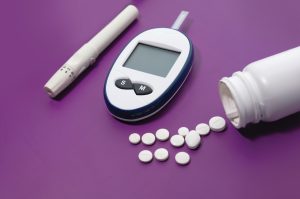Benfotiamine is a lipid-soluble form of thiamine (vitamin B1) often considered to be the most effective of the allithiamine group of naturally occurring, thiamine-derived compounds, found in trace quantities in roasted crushed garlic and other vegetables from the Allium genus (such as onions, shallots and leeks). It is absorbed much better than water-soluble thiamine salts: maximum plasma levels of thiamine are about five times higher after benfotiamine, the bioavailability is at maximum about 3.6 times as high as that of thiamine hydrochloride and better than other lipophilic thiamine derivates.1
Before further exploring the research and benefits of benfotiamine, it is important to understand the basics of thiamine since benfotiamine also performs the same functions.
A Review of Thiamine
Thiamine was one of the first organic compounds to be recognized as a vitamin.
In its coenzyme form, thiamine is required for a small number of very important enzymes that play critical roles in the production of energy from food, including the production of ATP.2 It is also required for the synthesis of the nucleic acids, DNA and RNA.3,4 A deficiency of thiamine may lead to the classic deficiency disease “beriberi,” characterized by:5
• Peripheral neuropathy
• Muscle pain and tenderness
• Rapid heart rate
• Enlargement of the heart
• Edema (severe swelling due to water retention)
• Congestive heart failure
Causes of Thiamine Deficiency
While thiamine deficiency is not common in the U.S., there are situations in which a deficiency may result from an increased requirement or excessive loss of this nutrient, as well as consumption of antithiamine factors. Situations in which there is an increased need for thiamine include strenuous physical exertion, fever, pregnancy, breast-feeding, adolescent growth and HIV-infection (with or without AIDS).6 Excessive thiamine loss may be caused by chronic alcohol abuse/alcoholism7, the use of diuretics8,9 and hemodialysis.10 Anti-thiamin factors, including thiaminases which inactivate thiamin, can also promote a loss of this vitamin. Consuming large amounts of tea and coffee (including decaffeinated), as well as habitually eating certain raw freshwater fish, raw shellfish and ferns are at higher risk of thiamin deficiency because these foods contain thiaminase normally inactivated by heat in cooking.11
Benfotiamine for Diabetes
Benfotiamine has particularly valuable benefits to offer for individuals with diabetes due to its unusual property of inhibiting three major pathways of diabetes- induced vascular damage and neuropathy, and also having value in treating diabetic retinopathy and kidney damage. The three pathways include the hexosamine pathway, the advanced glycation end product (AGE) formation pathway and the diacylglycerol (DAG)- protein kinase C (PKC) pathway.12 AGEs are particularly nasty, so inhibition of their formation is especially desirable.
Advanced Glycation End Product (AGE)
AGEs are formed from glycosylated proteins, which in turn are formed when glucose has attached itself to protein. For example, glucose can attach itself to the protein in red blood cells’ hemoglobin and form glycosylated hemoglobin, also called hemoglobin A1C, HbA1C, or just A1C for short. If this process continues to excess, one eventually ends up with AGEs, which become permanent fixtures in cells. AGE impregnated cells are very reactive and react with one another, and other proteins. In the case of blood capillaries, they can result in the walls of the capillaries thickening, eventually causing the vessels to be blocked off.13
Essentially, AGE reactions create chemical handcuffs, which gum up proteins, deactivate enzymes, trigger unhealthy biochemical signaling in cells and damages DNA, which contributes to the aging process. In a study on diabetic subjects, 600 mg of benfotiamine was supplemented for 28 days. Blood was drawn before and after treatment. The results were a significant reduction of intracellular glycoxidation and AGE formation.14
Neuropathy
Neuropathy is a collection of disorders that occurs when nerves of the peripheral nervous system are damaged. This is commonly referred to as peripheral neuropathy (PN). PN usually causes pain and numbness in the hands and feet. It can result from traumatic injuries, infections, metabolic disorders and exposure to toxins.
In a double-blind, randomized, placebo- controlled pilot study, 40 subjects with diabetic PN were given 400 mg benfotiamine daily or placebo for three weeks.Results showed a statistically significant improvement in the neuropathy score in the benfotiamine group compared to placebo, with the most significant improvement being a decrease in pain.15 Other research has demonstrated statistically significant effectiveness in reducing nerve pain with daily doses ranging between 150-320 mg benfotiamine.16
In addition, several studies have shown beneficial results when using benfotiamine in combination with other B vitamins in the treatment of diabetic neuropathy.17 In one study18, 30 subjects received 400 mg benfotiamine and 2,000 mcg of vitamin B12 daily for three weeks, followed by 150 mg benfotiamine and 750 mcg vitamin B12 daily for nine weeks, and another group of 15 subjects received a B-complex vitamin supplement three months. The results were that all patients treated with benfotiamine and vitamin B12 experienced significant relief in neuropathic pain and dramatic improvement in vibration perception thresholds, while subjects receiving a Bcomplex vitamin experienced only slight, non-statistically significant improvement.
An eight-week, randomized, multi-center, placebo-controlled, double-blind study compared the effect of 320 mg benfotiamine alone to 320 mg benfotiamine with viamins B6 and B12 or placebo in 84 alcoholic patients with neuropathy.
During weeks five through eight, the dose of benfotiamine was reduced to 120 mg daily. The results were that benfotiamine led to significant improvement in the entire range of symptoms of alcoholic neuropathy. For some reason the benfotiamine-alone group had better results than the benfotiamine with vitamins B6 and B12 group.19 In a Russian study, 14 chronic alcoholic men with neuropathy were given 450 mg benfotiamine daily for two weeks, followed by 300 mg daily for four weeks. The results showed a regression of neuropathy symptoms.20
Diabetic Retinopathy
Diabetic retinopathy is the most common diabetic eye disease and a leading cause of blindness in American adults. It is caused by damage to the blood vessels of the retina. In a nine-month animal study21, researchers administered benfotiamine to diabetic rodents to determine the potential for retinal protection.The results were that benfotiamine promoted normal AGE levels in the animals’ retina, as well as several key metabolic parameters within the animals’ cells. In addition, benfotiamine inhibited AGE-associated retinal damage.In an animal and in-vitro study22, researchers found that that supplementation with benfotiamine prevented experimental diabetic retinopathy in Rats, and completely prevented increases in AGE and PKU activity. This suggests that benfotiamine may help prevent or delay the progression of microvascular changes in patients with diabetic retinopathy.
Kidney Damage
Hemodialysis patients have an elevated level of damage to their genes in peripheral blood lymphocytes (PBLs) and an increased cancer incidence, possibly due to accumulation of toxins like AGEs.Since benfotiamine reduces AGE levels, and since hemodialysis patients tend toward vitamin B1 deficiency, researchers conducted two consecutive studies23 supplementing hemodialysis patients with benfotiamine. In both studies, benfotiamine significantly lowered gene damage of PBLs in hemodialysis patients, independent of changes in plasma AGE levels.
Since the antioxidative activity increased in treated patients, this may be the mechanism by which benfotiamine ameliorated the DNA damage.
Chronic renal insufficiency is when the filtering capacity of the kidneys are slowly and gradually destroyed, and the kidneys no longer have enough kidney function to maintain a normal state of health. Many patients with chronic renal insufficiency have decreased erythrocyte transketolase activity, which is a sign of thiamin deficiency. In clinical research24, 20 patients with end-stage renal disease where supplemented with a single 100 mg dose of benfotiamine or 100 mg of thiamin nitrate. The results were that patients receiving the benfotiamine experienced higher concentrations of a thiamine coenzyme, as well as improved erythrocyte transketolase activity. The researchers concluded that benfotiamine may be of clinical benefit in patients with end-stage renal disease.
Conclusion
Clearly, benfotiamine offers important benefits for individuals with diabetes.
Perhaps most significant is its ability to reduce AGE formation. This reduction may, in turn, reduce the risk for developing many of the complications associated with diabetes, including neuropathy, nephropathy and retinopathy.
For a full list of references, visit vitaminretailer.com and view the online edition.












